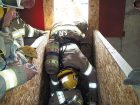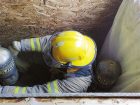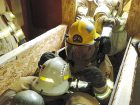
Features
Training
Editors’ pick 2015: Back to Basics
One of the more well-known drills in rapid-intervention team (RIT) training is the Denver drill. This drill is very physically demanding as it involves two RIT firefighters working to rescue a downed firefighter in a very small space. The drill was developed in Denver after the death of firefighter Mark Langvardt.
March 30, 2015
By Mark van der Feyst
On Sept. 28, 1992, Langvardt died in the line of duty while battling a three-alarm fire in a two-storey commercial building. The building, which was used for printing, was a split-level with a maze of rooms filled with furniture and office equipment. Langvardt was an engineer of truck company 16, which was assigned to interior operations. While inside, the firefighter was separated from his crew due to reduced visibility from the smoke, followed by a floor collapse.
Langvardt was able to get to a window and summon help using a flashlight. Firefighters outside noticed the light and immediately began a rescue operation. Langvardt was trapped in a room that was just 1.8 metres by 3.4 metres (six feet by 11 feet) and filled with filing cabinets. These cabinets formed aisles that were just 71 centimetres (28 inches) wide. The downed firefighter was located at the end of the aisles by a window that was 51 centimetres (20 inches) wide and 1.1 metres (3.5 feet) high. The floor was partially collapsed at the main entrance way, which prohibited firefighters from getting in. The rescue had to take place from the small window. Despite numerous attempts, firefighters were unable to remove Langvardt before he died.
Firefighters at the Denver Fire Department developed the Denver drill as a way to prevent the same or similar events from happening again. The Denver drill provides the skill sets needed to effectively complete a rescue if a firefighter were to become trapped in a small, confined space (see photo 1) with high windows, or requiring a high lift.
The first step of the Denver drill is to send one of the RIT members into the building through the window head first. This is difficult because of the high ledge and a length of distance the firefighter must fall down. The RIT member will need to use the body of the downed firefighter to help stabilize him during the decent, and should use his legs to grip the window frame in order to slow and control his body (see photo 2).
Once inside, the RIT member crawls over the downed firefighter and turns around so that he is facing the window again. The next step is to drag the downed firefighter forward and upright so that there is a space between the window wall and the back of the downed firefighter; to accomplish this, the RIT firefighter grabs the shoulder straps of the downed firefighter’s SCBA, places a foot or knee in the middle of the downed firefighter’s groin area, and pulls the downed firefighter toward him.
Next, a second RIT firefighter uses the same technique to enter the space between the downed firefighter and the window wall, using the back of the downed firefighter’s SCBA to help with the decent. Once inside, the second RIT member puts his back to the window wall, loosens his SCBA shoulder straps and places the SCBA cylinder at the corner of the wall (see photo 3).
The second RIT member then forms a ramp with his legs by placing his feet under or near the buttocks of the downed firefighter, and his knees close to his own upper body, making a triangle shape. At this point, the first RIT firefighter gets ready to begin to lift the downed firefighter; this involves sliding the downed firefighter as close as possible to the feet of the second RIT firefighter so that the buttocks of the downed firefighter is up against or on top of them.
The first RIT firefighter then positions his legs outside of the legs of the downed firefighter to create a wider base for lifting. The first RIT member then reaches down around the waist area of the downed firefighter and grabs the back of the waist belt of the SCBA (or bear hugs the downed firefighter) and then lifts the firefighter up and onto the legs or knees of the second RIT firefighter.
The second RIT firefighter places his hands on the downed firefighter’s SCBA bottle to help lift and to guide the firefighter onto the ramp formed by his legs and knees. At this point, the downed firefighter should be off the ground and onto the legs of the second RIT firefighter, allowing the first RIT firefighter to re-position for the final segment.
The first RIT firefighter then places his shoulders underneath the legs of the downed firefighter, positioning the firefighter’s knees over his shoulders. This allows the first RIT firefighter to push while the second RIT firefighter lifts up from the bottom. Two other RIT members are at the window on the outside ready to receive the downed firefighter. The two exterior RIT members should reach in and grab the SCBA shoulder straps of the downed firefighter to help with removal (see photo 4).
When all RIT members are in position, the first RIT firefighter yells the command and all members either push up, push forward or pull toward themselves to elevate the downed firefighter high enough to be pulled out the window. The RIT members inside the building then exit the same way they came in through the window, receiving help as needed from the outside RIT members.
This type of rescue can be used in any situation that involves a high lift with a difference in elevation, or a high window that cannot be enlarged into a doorway.
Mark van der Feyst has been in the fire service since 1999 and is a full-time firefighter in Ontario. He teaches in Canada, the United States and India and is lead author of Residential Fire Rescue. Mark@FireStarTraining.com
Print this page



